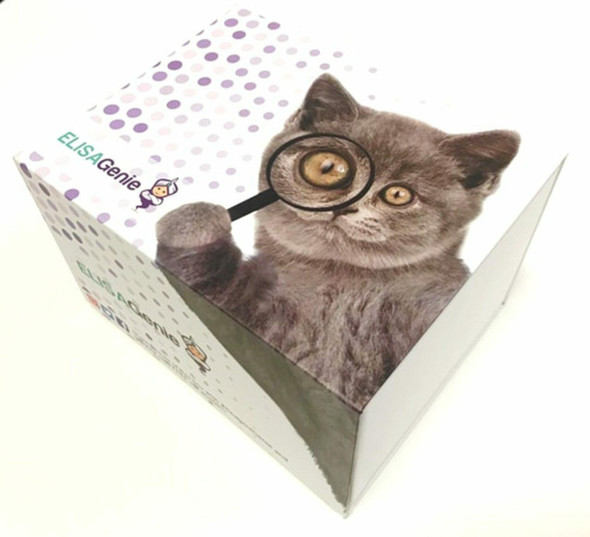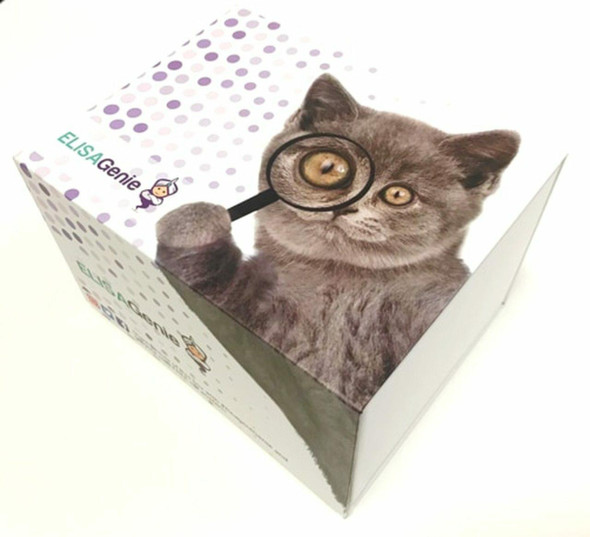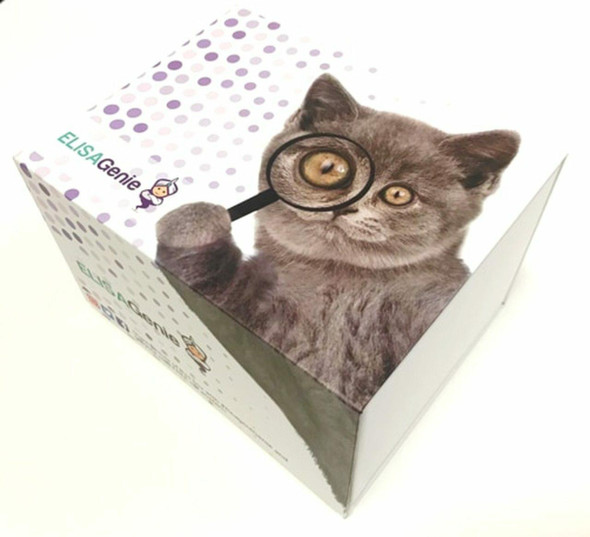Human Kinesin heavy chain isoform 5A (KIF5A) ELISA Kit (HUEB0438)
- SKU:
- HUEB0438
- Product Type:
- ELISA Kit
- Size:
- 96 Assays
- Uniprot:
- Q12840
- Range:
- 0.312-20 ng/mL
- ELISA Type:
- Sandwich
- Synonyms:
- KIF5A, NKHC, MY050, SPG10, Kinesin heavy chain neuron-specific 1, Neuronal kinesin heavy chain
- Reactivity:
- Human
Description
Human Kinesin heavy chain isoform 5A (KIF5A) ELISA Kit
The Human KIF5A (Kinesin Heavy Chain Isoform 5A) ELISA Kit is specifically designed for the precise quantification of KIF5A levels in human samples including serum, plasma, and cell culture supernatants. With its high sensitivity and specificity, this kit ensures accurate and reproducible results, making it an ideal tool for various research applications.KIF5A is a critical motor protein involved in intracellular transport and plays a key role in neuronal development and function. Dysregulation of KIF5A has been linked to neurodegenerative diseases such as amyotrophic lateral sclerosis (ALS) and hereditary spastic paraplegia.
Therefore, the ability to accurately measure KIF5A levels is crucial for understanding its role in these diseases and identifying potential therapeutic targets.By using the Human KIF5A ELISA Kit, researchers can gain valuable insights into the function of KIF5A and its implications in neurological disorders, paving the way for advancements in disease diagnosis and treatment strategies.
| Product Name: | Human Kinesin heavy chain isoform 5A (KIF5A) ELISA Kit |
| SKU: | HUEB0438 |
| Size: | 96T |
| Target: | Human Kinesin heavy chain isoform 5A (KIF5A) |
| Synonyms: | Kinesin heavy chain neuron-specific 1, Neuronal kinesin heavy chain, NKHC, NKHC1 |
| Assay Type: | Sandwich |
| Detection Method: | ELISA |
| Reactivity: | Human |
| Detection Range: | 0.312-20ng/mL |
| Sensitivity: | 0.12ng/mL |
| Intra CV: | 5.6% | ||||||||||||||||||||
| Inter CV: | 7.9% | ||||||||||||||||||||
| Linearity: |
| ||||||||||||||||||||
| Recovery: |
| ||||||||||||||||||||
| Function: | Microtubule-dependent motor required for slow axonal transport of neurofilament proteins (NFH, NFM and NFL). Can induce formation of neurite-like membrane protrusions in non-neuronal cells in a ZFYVE27-dependent manner. The ZFYVE27-KIF5A complex contributes to the vesicular transport of VAPA, VAPB, SURF4, RAB11A, RAB11B and RTN3 proteins in neurons. |
| Uniprot: | Q12840 |
| Sample Type: | Serum, plasma, tissue homogenates, cell culture supernates and other biological fluids |
| Specificity: | Natural and recombinant human Kinesin heavy chain isoform 5A |
| Sub Unit: | Oligomer composed of two heavy chains and two light chains. Interacts with GRIP1. Interacts with FMR1 (via C-terminus); this interaction is increased in a mGluR-dependent manner. Interacts with ZFYVE27. Interacts with VAPA, VAPB, SURF4, RAB11A (GDP-bound form), RAB11B (GDP-bound form) and RTN3 in a ZFYVE27-dependent manner (By similarity). Interacts with BORCS5 (PubMed:25898167). Interacts with BICD2 (PubMed:20386726). |
| Subcellular Location: | Cytoplasm Perinuclear region Cytoplasm Cytoskeleton Concentrated in the cell body of the neurons, particularly in the perinuclear region. |
| Storage: | Please see kit components below for exact storage details |
| Note: | For research use only |
| UniProt Protein Function: | KIF5A: Microtubule-dependent motor required for slow axonal transport of neurofilament proteins (NFH, NFM and NFL). Defects in KIF5A are the cause of spastic paraplegia autosomal dominant type 10 (SPG10). An inherited degenerative spinal cord disorder characterized by a slow, gradual, progressive weakness and spasticity (stiffness) of the legs. Rate of progression and the severity of symptoms is quite variable. Initial symptoms may include difficulty with balance, weakness and stiffness in the legs, muscle spasms, and dragging the toes when walking. In some forms of the disorder, bladder symptoms (such as incontinence) may appear, or the weakness and stiffness may spread to other parts of the body. Belongs to the kinesin-like protein family. Kinesin subfamily. |
| UniProt Protein Details: | Protein type:Motor; Microtubule-binding Chromosomal Location of Human Ortholog: 12q13.13 Cellular Component: kinesin complex; microtubule; membrane; perinuclear region of cytoplasm; cytosol Molecular Function:protein binding; plus-end-directed microtubule motor activity; microtubule binding; ATPase activity; motor activity; ATP binding Biological Process: synaptic transmission; axon guidance; protein localization; metabolic process; antigen processing and presentation of exogenous peptide antigen via MHC class II; cytoskeleton-dependent intracellular transport; blood coagulation; microtubule-based movement Disease: Spastic Paraplegia 10, Autosomal Dominant |
| NCBI Summary: | This gene encodes a member of the kinesin family of proteins. Members of this family are part of a multisubunit complex that functions as a microtubule motor in intracellular organelle transport. Mutations in this gene cause autosomal dominant spastic paraplegia 10. [provided by RefSeq, Jul 2008] |
| UniProt Code: | Q12840 |
| NCBI GenInfo Identifier: | 143811412 |
| NCBI Gene ID: | 3798 |
| NCBI Accession: | Q12840.2 |
| UniProt Secondary Accession: | Q12840,Q4LE26, A6H8M5, |
| UniProt Related Accession: | Q12840 |
| Molecular Weight: | 117,378 Da |
| NCBI Full Name: | Kinesin heavy chain isoform 5A |
| NCBI Synonym Full Names: | kinesin family member 5A |
| NCBI Official Symbol: | KIF5A |
| NCBI Official Synonym Symbols: | NKHC; MY050; SPG10; D12S1889 |
| NCBI Protein Information: | kinesin heavy chain isoform 5A; KIF5A variant protein; neuronal kinesin heavy chain; kinesin heavy chain neuron-specific 1; kinesin, heavy chain, neuron-specific |
| UniProt Protein Name: | Kinesin heavy chain isoform 5A |
| UniProt Synonym Protein Names: | Kinesin heavy chain neuron-specific 1; Neuronal kinesin heavy chain; NKHC |
| Protein Family: | Kinesin |
| UniProt Gene Name: | KIF5A |
| UniProt Entry Name: | KIF5A_HUMAN |
| Component | Quantity (96 Assays) | Storage |
| ELISA Microplate (Dismountable) | 8×12 strips | -20°C |
| Lyophilized Standard | 2 | -20°C |
| Sample Diluent | 20ml | -20°C |
| Assay Diluent A | 10mL | -20°C |
| Assay Diluent B | 10mL | -20°C |
| Detection Reagent A | 120µL | -20°C |
| Detection Reagent B | 120µL | -20°C |
| Wash Buffer | 30mL | 4°C |
| Substrate | 10mL | 4°C |
| Stop Solution | 10mL | 4°C |
| Plate Sealer | 5 | - |
Other materials and equipment required:
- Microplate reader with 450 nm wavelength filter
- Multichannel Pipette, Pipette, microcentrifuge tubes and disposable pipette tips
- Incubator
- Deionized or distilled water
- Absorbent paper
- Buffer resevoir
*Note: The below protocol is a sample protocol. Protocols are specific to each batch/lot. For the correct instructions please follow the protocol included in your kit.
Allow all reagents to reach room temperature (Please do not dissolve the reagents at 37°C directly). All the reagents should be mixed thoroughly by gently swirling before pipetting. Avoid foaming. Keep appropriate numbers of strips for 1 experiment and remove extra strips from microtiter plate. Removed strips should be resealed and stored at -20°C until the kits expiry date. Prepare all reagents, working standards and samples as directed in the previous sections. Please predict the concentration before assaying. If values for these are not within the range of the standard curve, users must determine the optimal sample dilutions for their experiments. We recommend running all samples in duplicate.
| Step | |
| 1. | Add Sample: Add 100µL of Standard, Blank, or Sample per well. The blank well is added with Sample diluent. Solutions are added to the bottom of micro ELISA plate well, avoid inside wall touching and foaming as possible. Mix it gently. Cover the plate with sealer we provided. Incubate for 120 minutes at 37°C. |
| 2. | Remove the liquid from each well, don't wash. Add 100µL of Detection Reagent A working solution to each well. Cover with the Plate sealer. Gently tap the plate to ensure thorough mixing. Incubate for 1 hour at 37°C. Note: if Detection Reagent A appears cloudy warm to room temperature until solution is uniform. |
| 3. | Aspirate each well and wash, repeating the process three times. Wash by filling each well with Wash Buffer (approximately 400µL) (a squirt bottle, multi-channel pipette,manifold dispenser or automated washer are needed). Complete removal of liquid at each step is essential. After the last wash, completely remove remaining Wash Buffer by aspirating or decanting. Invert the plate and pat it against thick clean absorbent paper. |
| 4. | Add 100µL of Detection Reagent B working solution to each well. Cover with the Plate sealer. Incubate for 60 minutes at 37°C. |
| 5. | Repeat the wash process for five times as conducted in step 3. |
| 6. | Add 90µL of Substrate Solution to each well. Cover with a new Plate sealer and incubate for 10-20 minutes at 37°C. Protect the plate from light. The reaction time can be shortened or extended according to the actual color change, but this should not exceed more than 30 minutes. When apparent gradient appears in standard wells, user should terminatethe reaction. |
| 7. | Add 50µL of Stop Solution to each well. If color change does not appear uniform, gently tap the plate to ensure thorough mixing. |
| 8. | Determine the optical density (OD value) of each well at once, using a micro-plate reader set to 450 nm. User should open the micro-plate reader in advance, preheat the instrument, and set the testing parameters. |
| 9. | After experiment, store all reagents according to the specified storage temperature respectively until their expiry. |
When carrying out an ELISA assay it is important to prepare your samples in order to achieve the best possible results. Below we have a list of procedures for the preparation of samples for different sample types.
| Sample Type | Protocol |
| Serum | If using serum separator tubes, allow samples to clot for 30 minutes at room temperature. Centrifuge for 10 minutes at 1,000x g. Collect the serum fraction and assay promptly or aliquot and store the samples at -80°C. Avoid multiple freeze-thaw cycles. If serum separator tubes are not being used, allow samples to clot overnight at 2-8°C. Centrifuge for 10 minutes at 1,000x g. Remove serum and assay promptly or aliquot and store the samples at -80°C. Avoid multiple freeze-thaw cycles. |
| Plasma | Collect plasma using EDTA or heparin as an anticoagulant. Centrifuge samples at 4°C for 15 mins at 1000 × g within 30 mins of collection. Collect the plasma fraction and assay promptly or aliquot and store the samples at -80°C. Avoid multiple freeze-thaw cycles. Note: Over haemolysed samples are not suitable for use with this kit. |
| Urine & Cerebrospinal Fluid | Collect the urine (mid-stream) in a sterile container, centrifuge for 20 mins at 2000-3000 rpm. Remove supernatant and assay immediately. If any precipitation is detected, repeat the centrifugation step. A similar protocol can be used for cerebrospinal fluid. |
| Cell culture supernatant | Collect the cell culture media by pipette, followed by centrifugation at 4°C for 20 mins at 1500 rpm. Collect the clear supernatant and assay immediately. |
| Cell lysates | Solubilize cells in lysis buffer and allow to sit on ice for 30 minutes. Centrifuge tubes at 14,000 x g for 5 minutes to remove insoluble material. Aliquot the supernatant into a new tube and discard the remaining whole cell extract. Quantify total protein concentration using a total protein assay. Assay immediately or aliquot and store at ≤ -20 °C. |
| Tissue homogenates | The preparation of tissue homogenates will vary depending upon tissue type. Rinse tissue with 1X PBS to remove excess blood & homogenize in 20ml of 1X PBS (including protease inhibitors) and store overnight at ≤ -20°C. Two freeze-thaw cycles are required to break the cell membranes. To further disrupt the cell membranes you can sonicate the samples. Centrifuge homogenates for 5 mins at 5000xg. Remove the supernatant and assay immediately or aliquot and store at -20°C or -80°C. |
| Tissue lysates | Rinse tissue with PBS, cut into 1-2 mm pieces, and homogenize with a tissue homogenizer in PBS. Add an equal volume of RIPA buffer containing protease inhibitors and lyse tissues at room temperature for 30 minutes with gentle agitation. Centrifuge to remove debris. Quantify total protein concentration using a total protein assay. Assay immediately or aliquot and store at ≤ -20 °C. |
| Breast Milk | Collect milk samples and centrifuge at 10,000 x g for 60 min at 4°C. Aliquot the supernatant and assay. For long term use, store samples at -80°C. Minimize freeze/thaw cycles. |







